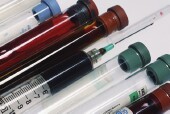- Skip Storing This Everyday Product in the Fridge Door
- Green Tea + B3 Pairing May Boost Brain Health
- Navigating Your Midlife Crisis: Embracing New Possibilities
- City Raccoons Showing Signs of Domestication
- Mapping the Exposome: Science Broadens Focus to Environmental Disease Triggers
- One Week Less on Social Media Linked to Better Mental Health
- Your Brain Changes in Stages as You Age, Study Finds
- Some Suicide Victims Show No Typical Warning Signs, Study Finds
- ByHeart Formula Faces Lawsuits After Babies Sickened With Botulism
- Switch to Vegan Diet Could Cut Your Greenhouse Gas Emissions in Half
Blood, Saliva Tests May Spot Head and Neck Cancers Early


Scientists report they’ve found DNA from head and neck cancer tumors in patients’ blood and saliva samples, a development that potentially could lead to early diagnosis of these malignancies.
Although not yet ready for real-world use, such tests could also help in planning and monitoring treatment, the Johns Hopkins University researchers said.
“Tumor DNA has potential to be used as a marker for screening, early detection, monitoring during treatment and surveillance after cancer treatment,” said lead researcher Dr. Nishant Agrawal, an associate professor of otolaryngology head and neck surgery.
“In the near future, there will be a noninvasive test that can be used to monitor cancer,” Agrawal said.
This preliminary study involved fewer than 100 patients. “More study is necessary to validate the findings in larger groups of patients and healthy people, improve the test performance and define the precise indications for the test,” he added.
Agrawal said the test is very accurate, identifying DNA shed by cancer tumors 100 percent of the time and ruling out cancer 96 percent of the time.
The goal is to use the test to monitor cancer patients for persistence and/or recurrence of their disease, Agrawal said. “Another goal is to use the test for screening to find head and neck cancers in the general population or high-risk populations,” he added.
Currently, the test is for research purposes only, Agrawal said. “Once the test is validated and approved for clinical use, a positive test would lead to additional diagnostic tests and treatment,” he said.
The report was published June 24 in the journal Science Translational Medicine.
Major risk factors for head and neck cancers are alcohol, tobacco — including chewing tobacco — and HPV (human papillomavirus) infection, the researchers said. These cancers occur in the mouth, including the lips, front of the tongue, cheeks and gums, and in the back of the throat and voice box.
For the study, Agrawal’s team got saliva samples from 93 patients newly diagnosed with head and neck cancer or with recurrent cancer. Forty-seven also gave blood samples.
The researchers found tumor DNA in the saliva of 71 patients (76 percent) and in the blood of 41 patients (87 percent). In 45 of the 47 who who gave both blood and saliva, investigators were able to identify tumor DNA in at least one of the fluids.
Specifically, Agrawal and colleagues searched blood and saliva for traces of HPV, which accounts for a growing number of these cancers. For cancers not related to HPV, they looked for mutations in specific cancer-related genes.
Breaking down the results, Agrawal’s team found saliva tests were better at identifying cancers in the mouth, while blood tests detected more cancers in the throat. Combining the two could help identify cancers anywhere in this region, Agrawal’s said.
If the test were to become routinely used, Agrawal expects it would cost several hundred dollars, although he’d like to see it priced at less than $50 and given by doctors and dentists.
Dr. Leonard Lichtenfeld, deputy chief medical officer of the American Cancer Society, said if this test and others like it pan out, it will be a major contribution to finding and treating cancers early when they are most curable.
“But this is not something that is ready yet to be used in the clinic,” he said.
Lichtenfeld said this approach — looking for cancer markers in blood — may also help identify other cancers. However, researchers first need to find the specific DNA that different cancers shed, he said.
“No two cancers have the same DNA mutations,” Lichtenfeld said. “It might be possible to have blood tests that detect these specific abnormalities.”
This study is an early step, Lichtenfeld added, “but a step that shows we can make this happen.”
More information
For more on head and neck cancer, visit the U.S. National Cancer Institute.
Source: HealthDay
Copyright © 2025 HealthDay. All rights reserved.










